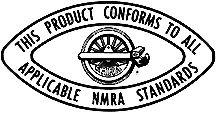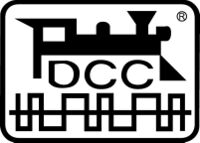National Model Railroad Association (NMRA)
Summary: The National Model Railroad Association, is a non-profit organization for those involved in the hobby or the business of model railroading.
Organisation
The NMRA has Divisions at the local level, organized into Regions. Divisions may have meets on a regular basis, and there are annual Regional Conventions which allow members to socialize, enter contests and attend clinics on various topics. At the National level there is a convention and train show held yearly.
Creation of Standards
- Main article: NMRA/NMRA Standards
The best-known activity of the NMRA is the creation of Standards, and documents known as Recommended Practices (RP), for model railroad equipment. Many standards defined by the NMRA are widely followed by the industry and modellers, including their HO scale track and wheel standards (S-3, S-4) and related RPs (RP2, 8, 10-15, and 25), the Digital Command Control (DCC) standard set (S-9.1, S-9.2, and RP9.1.1 through RP9.3.2), and NMRAnet standard set (S-9.7) in development.
The main reason for the creation of the NMRA was to encourage inter-operability between manufacturers, which was a serious issue in the early days. Your trains may or may not have worked on a friend's layout. Today, thanks to the efforts of the NMRA, that is not a problem.
Limitations of Standards
It is important to recognize the scope of the NMRA's Digital Command Control specification. The specifications only cover the electrical signal and data format applied to tracks by the Digital Command Control System; which is the signal read by a multifunction decoder or an Accessory Decoder. No other portion of the a DCC system is specified by the NMRA – as long as the signal on the tracks meets the NMRA specifications, manufacturers are free to deploy any configuration they choose. As a result, a DCC system can be as simple as an entire-system-in-one-device, to complex DCC systems built from dozens of components. It means that the throttle can be a simple device with a knob to control speed, or a complex device with a graphical interface. The NMRA DCC Standard describes only the signals on the rails.
As part of the Standard, there are a number of mandatory functions the decoders must have, to insure inter-operability. These are in the form of Configuration Values, or CVs. The NMRA has specified a number of them as mandatory, as well as a number of optional CVs. The decoder designer must include some CVs, for compatibility, but is free to add features like advanced lighting, greater motor control options, and other features. Sound is a example of a decoder feature which is not included in the NMRA DCC Standard. This allows manufacturers a lot of freedom when designing the decoder's software.
The NMRA Digital Command Control Standard is just that: A Standard. Any locomotive with a DCC Compatible decoder will work with any DCC System. Much like other NMRA Standards which make it possible for freight cars to roll on the track and through switches, regardless of who made them.
DCC is a Command Control system. It is not the first command control system ([see DCC History). And it is likely not the last. But today – it is state of the art.
Education
The NMRA considers the education of model railroaders and encourages modellers to learn and improve their skills to be part of its mission. The NMRA runs an Achievement Program to encourage these skills, and runs modelling contests.
The NMRA is home of the A.C. Kalmbach Memorial Library, which houses railroad-related books and videos, and was recently designated as the official railroad library of the state of Tennessee. The library is adjacent to the Norfolk Southern Railway Georgia Division and the Tennessee Valley Railroad Museum. It is named for Al C. Kalmbach, founder of Kalmbach Publishing, whose original magazines are Model Railroader and Trains. Al Kalmbach was also member number one of the NMRA, as one of the founders and supporters of the NMRA.
Promotion of Model Railroading as a Hobby
Promotion of the model railroading hobby is part of the NMRA's purpose. As part of their mission, the NMRA publishes the NMRA Magazine (formerly Scale Rails, and originally called The NMRA Bulletin) which features articles and reviews of interest to the members, as well as publishing new standards and NMRA news. The NMRA Magazine is exclusive to the membership. There may also be Regional and Divisional publications, check their websites for details.
Digital Command Control
The NMRA created a standard protocol for command control, using digital technology, which is known today as Digital Command Control. The standard was created in response to the confusion in the marketplace caused by many incompatible command control systems which appeared and disappeared over the years. This confusion prevented the adoption of any one command control system as modellers were hesitant to invest substantial sums of money on equipment that could be obsolete and unsupported in the future.
With the introduction of the NMRA DCC Standard, a common method of command control was possible, where modellers could confidently invest in a DCC system without concerns over support or future supply of components. This created a healthy market for command control systems, based on the NMRA DCC standard.
Standards and Recommended Practices
A Standard is a requirement which is mandatory, "carved in stone" so to speak and must be followed to facilitate interchange or interface, whichever the case may be. These can be changed from time to time but ONLY by the vote of the NMRA membership after proper policy procedures have been followed and the membership has been fully informed.
Examples are those for track gauge and coupler height.
Recommended Practices (RP) are recommendations which the Engineering Committee has established through actual tests and feel are beneficial to operation. These are not required to be voted by the membership except when in a package such as the Module Standards and RPs. These are presented to the Board of Trustees (BOT) for their study and approval. "NMRA Website, Introduction and Overview" .
Examples of recommended practices are those for Track Centers and Obstacle Clearance, Rail, Wheel Profile and Turnout Construction.
Following the RPs will help you build a railroad that operates well using practices which have been proven correct over time.
Examples of Standards and Recommended Practices
RP25 Wheels
The RP25 "RP-25 RP-25" . wheel design in particular has been critical in ensuring the reliability and interoperability of US-prototype model railroad equipment, since practically every manufacturer of such equipment uses wheels conforming to the RP. This is in marked contrast to the British market, in which there is no accepted standard among manufacturers. In Europe, the Normen Europäischer Modelleisenbahnen (NEM) standard is widely followed, but this is generally further away from prototype accuracy than NMRA standards, and the NEM wheel design is particularly so.
One difference in wheel standards is notable: The NEM standard calls for a 3º taper of the wheel's tread, whereas the NMRA only recommends a 3º taper.
Digital Command Control Standards
The NMRA DCC Standards fall under Electrical Standards. S-9.1.x and S-9.2.x cover DCC Standards
See the external links at the end of this page for the NMRA Standards and Recommended Practices page.
Couplers
The NMRA has never defined a coupler standard, because the NMRA will not endorse a commercial product. The NMRA does test products and issue a Conformance Warrant indicating it meets the applicable standards.
HO Couplers
In 1953 the NMRA Standards Committee presented a report which proposed standardising the HO coupler. [1]
At the time the situation in HO was chaotic. A number of different coupler designs were in use:
- American Flyer
- Baker (used by John Allen)
- Fleischmann
- K&W
- Kadee (an early version)
- Kupeeze
- LaNal
- Mantua
- Marklin
- Megow
- Penn Line
- Walthers
- A variety of generic AAR dummy couplers
Most were incompatible, especially the AAR types. The automatic types were also rife with incompatibilities.
A selection of prototypes was shown to great interest. Manufacturers, already making their own couplers, were very vocal, as they saw no need to replace their tooling for a new coupler design. Eventually it was agreed that the NMRA would work towards a standardized coupler pocket.
At a meeting in May 1956, it was reported that all ready to run manufacturers could use an NMRA coupler, and the kit situation would sort itself. After discussions it was determined that the NMRA coupler design should not be considered a standard until a period of time had elapsed to allow for observation of their operation in real applications. The coupler which came out of these meetings was the X2f or NMRA coupler.
The topic would arise again in January 1957, after much discussion it was decided to leave the issue to the manufacturers which would be meeting in February for their association's trade show.
While the X2f or horn-hook did become the "standard coupler" used in train sets, it did not become an NMRA Standard. The NMRA did not insist that the X2f was the coupler. Since it was royalty and patent free, it began to appear on ready to run rolling stock and included with kits. In the same time period, Kadee couplers become popular due to their appearance and reliability.
As the X2f was never defined in an NMRA Standard, it never reached the potential the committee which designed it hoped for. Every manufacturer deviated from the original design and tolerances, using various plastics and metals with their own friction and sliding properties and a variety of springs.
During the next decade the Kadee coupler became the de facto standard among modellers. John Allen was offered Kadee couplers at no charge, but he decided it wasn't worth the trouble to replace the existing Baker couplers used on his layout.
Conformance Warrants
Many DCC manufacturers do not seek a Conformance Warrant, which does not mean the device does not meet the NMRA Standard. Products with the NMRA DCC logo on them must meet the NMRA DCC standards. If certain features are not available, for example certain speed step modes not supported, the packaging must state that so the buyer can make an informed decision, or the package may not carry the NMRA DCC Logo.
Additional Membership Benefits
- The NMRA has over 100,000 images, drawings, plans and paint diagrams available online, with more being added. High resolution files are available for purchase, with a discount for members.
- Achievement Program: As part of their education mandate, a Certificate is offered to those who learn and master skills needed. Completion of the program results in the award of a Master Model Railroader certification.
- Conventions: The NMRA has the national convention annually. It usually runs for a week and features many clinics, layout and prototype tours. Regional conventions vary from two to five days, with similar features.
- Special Access: Often as part of a convention, access is available as tours of prototype facilities, or layouts which rarely open to visitors. Speakers may also present a topic on model or prototype railroading or other topics, such as DCC, which are of interest. These speakers are often specialists in their field and can offer you unique perspectives.
- Electronic Bulletins with late breaking news and updates.
- Liability Insurance for clubs which are made up of 100% NMRA members.
- Liability insurance for NMRA sponsored events, such as meets and shows.
- Members Only Company Store. Great place to get mugs and Gauges, and other items.
- Discounts and advance reservations on books offered for sale by the Kalmbach Memorial Library.
- Modelling with the Masters: An intense workshop on beginner and intermediate techniques with instruction by Master Model Railroaders. Often offered at the National Convention, and sometimes at regional conventions.
- Clinic slides, tapes and DVDs are available for rent.
- Collection Insurance for your collection of model railroad related items
The NMRA makes available to its members a full collection of Data Sheets published on their website and new ones appear in the NMRA Magazine. These cover a multitude of topics in nine categories from tools, scenery, structures to locomotives and rolling stock.
NMRA Members are also welcome to observe Board of Directors meetings.
Footnotes
References
- ↑ Hal Carstens, Railroad Model Craftsman, August 1991, "Notes on an old timetable"
Further Reading
- DCC History - The history of command control up to the NMRA DCC standard.
- NMRA DCC Plug - How the 8-pin medium-sized plug is wired up.
- MOROP - The European standards organization for model railroads.
- NEM - The model railroad standards issued by MOROP.
- NMRAnet - Accessory bus based on CAN and Ethernet, in development.
- All About Standards For Beginners
External Links
If you want more information on local divisions, see Regions
(Majority of this page's content was taken from Wikipedia)



